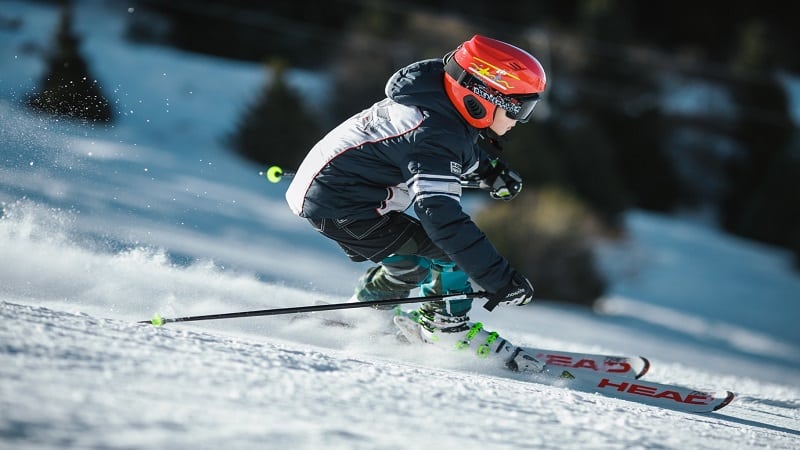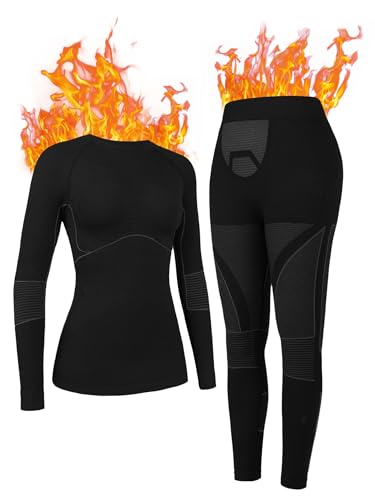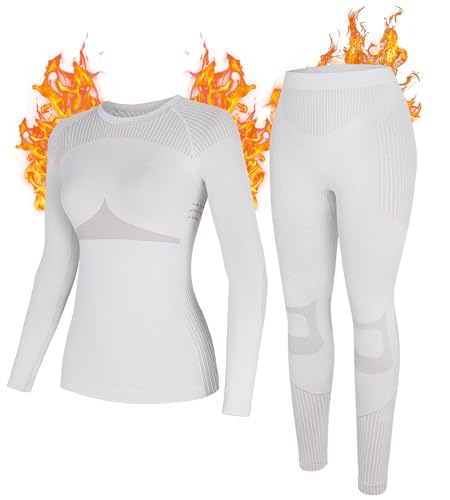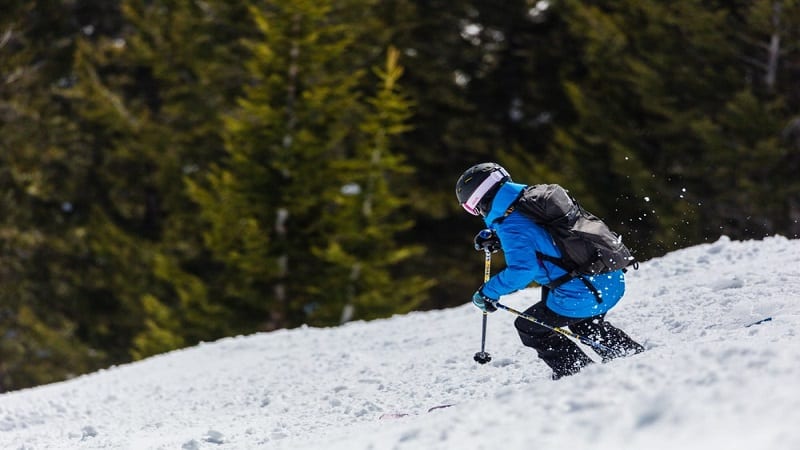If you are just about to enter the world of winter sports and have decided to give skiing a shot on your first go, you must keep a few things in mind. Being prepared for skiing can make or break your entire skiing experience. Without the right clothes, you are setting yourself up for the worst skiing trip ever. Our list of best clothes for skiing will keep you warm, protected and give you a full range of movement in the harsh winter season.

Yes, skiing gear takes more money as the skiing clothes are on the pricier side, but remember that these clothes and skiing equipment is a one-time investment that will last you years to come.
So, where do you start?
Well, the best way to pick what to wear is to start from the bottom and work your way up. It is important to remember not to wear cotton clothing as cotton absorbs all the sweat and makes you freeze, which you want to avoid at all costs. Now let’s get into the ski gear that will allow you to have a great experience on the slopes every time.
The 7 Best Clothes for Skiing
There is a list of skiing clothes that you need to have a safe and enjoyable skiing experience. We have listed the top seven that will ensure your first trip out in the hills is one that you will remember for a long time.
Ski Socks
Starting from the bottom, which is your feet, the most important thing you need is a good pair of ski socks. A great skiing day can turn into your worst nightmare if you’ve cold feet. You can easily avoid this by investing in good-quality ski socks made from synthetic material or wool.
Most people have a common misconception that there’s no need to get an expensive pair of socks as layering will do the same. It is the worst thing you can do to yourself as this can lead to your feet overheating, causing blisters and discomfort in your feet.
A good-quality pair of socks will keep you warm, comfortable and absorb any moisture, giving you the best skiing experience.
Thermal Ski Socks
These thermal ski socks are high-performance socks with a long hose, stretchable comfort top, and padded shin bone protection. They will give your feet the ultimate care while skiing.
They are great for machine wash and will not wear out because of their high quality. These socks will help keep your feet warm and dry in extreme conditions. They are perfect for all skiing activities, and they feature grip zones and extra cushioning for extra foot and ankle support.
Base Layers
A base layer is a must-have for skiing. These are like long underwear, but the true purpose is to keep you dry all day long and not warm, which is a common misconception. These should be made of either synthetic materials like polyester or natural fibers such as merino wool. It helps to aggressively carry the seat off your skin to evaporate, which is a process known as wicking.
Base layers on the cheaper side, made of synthetics, make you smelly quite easily. However, natural fibers such as merino and bamboo are pricier and help keep germs away.
Thermal Underwear Set
This thermal underwear set provides rapid absorption of sweat and prevents body odor. It features breathable and wicking polyester fabric, which will help absorb sweat from your body instantly and help you keep away from bad body odor, along with keeping you dry and cozy.
It is extremely warm and light as this set comes with fleece lining and is excellent to keep you warm, allowing you great performance and windproof function in the cold weather. It traps the heat inside, keeping you warm throughout.
It allows you free movement and prevents strain on the body. The long sleeve set is designed with four times the stretchable fabric and offers excellent comfort with your muscles’ full range of movement. The moisture-wicking underwear with superelasticity provides a maximum balance between your muscles.
Mid Layers
From sub-zero temperatures, it is crucial to have mid-layers. Fleeces tend to be made using breathable manufactured synthetic or out of merino wool, and they come in a range of weights.
Mid-layers are worn on top of your base layers, and these are thin jumpers made out of fleece or wool. A lightweight fleece is the best option for intense activities, but it’s worth going for a heavier mid-layer to keep warm if you are a beginner.
However, the thin jumpers tend to be warmer than the thick ones as they trap the air between them. Mid-layers range from tight-fitting, synthetic fleeces to hoodies and inner jackets.
Most people don’t bother wearing their mid-layers on the legs as they think that legs do most of the work, so they’ll be warm anyway and that it’s the upper body that needs most layering. It is wrong to do so. Your mid-layer is your second layer of defense against the harsh winters, especially if you’re going in for the first time.
Water Repellent Mid Layer Top
This fabric features water-resistant technology, which makes it suitable in light rainy conditions. It has a lockable zip puller that will provide security and comfort in all your movements and remain warm.
The breathable materials used to make this mid-layer helps it remain lightweight and quick drying. It will allow you to remain dry and warm throughout your skiing activity.
Outer Layers
To secure everything, you will need a waterproof outer layer that helps keep everything out. These include good quality ski jackets and ski trousers or pants that will ensure that the wind, snow, sleet, and rain stay out while you stay warm inside.
The outer layer is generally the most expensive one. Most ski fields give you the option to hire these, which is a great way of reducing the cost. It is best to rent or buy outer layers will several pockets to help you hold your ski equipment on the cold winter days.
Make sure the ski clothing that you choose for your outer layer is insulated and waterproof. Keep in mind that you will be spending quite some time out in the cold and sometimes on your bum, and for that, you need extra insulation as it will help keep the cold out.
Don’t make the mistake of wearing your everyday clothes as the outer layer, such as jeans. They will get wet, heavy and will end up freezing you out in the cold.
The price of the materials depends on what the material is. Is it waterproof and breathable? These are huge factors that affect the price of the outer layers.
Waterproof Fleece Jacket
This waterproof jacket is a true savior when it comes to enjoying your time outdoors in extreme weather conditions. These are made from performance shells for waterproof protection. You can easily rely on its tough non-tear outer, as the ripstop face fabrics offer you immense durability and excellent performance on the chilly slopes.
It offers a windproof function that helps you stay warm all day long. Thanks to the adjustable cuffs, they prevent the cold from entering. And it had multiple pockets to help you keep your essentials and hold your gear.
Ski Pants/ Salopettes
Ski pants, also known as salopettes, are an essential part of your outer layer of clothing. These, too, should be waterproof and breathable. It is important to ensure that they have an elastic cuff at the bottom of each leg – this allows your boot to avoid any snow from getting inside and helps vent for temperature regulation. Loose fits are popular with borders as they have a greater range of movement and flexibility.
Heatwave Thermal Trousers
These heatwave thermal trousers are a great base layer. They are made with a velvety groomed interior that is made from an innovative shielding fiber which offers a high-performance protection. They offer a comfortable fit. The ribbed construction shapes the contours of the body. They hold more warm air inside to keep you dry and warm throughout.
Ski Gloves
You have to take care of your hands too! How else are you going to hold the skiing gear? Make sure you own a warm pair of waterproof gloves or mittens, as it gets impossible to work without them. There are various styles of gloves. Some come with detachable layers that help hold your drinks.
Whatever gloves you choose, make sure they are top quality as you cannot compromise your hands. Make sure they are comfortable and allow you enough room for your fingers to move easily and that they are long enough to fit your palms completely.
Anjetan Waterproof Thermal Gloves
These thick windproof gloves will provide you with the warmth you need. They are lined with TR plus velvet and mid-layer insulation cotton, which is great for absorbability and breathability. They offer excellent grip and control of items, especially your phone. The outer material of the thermal riding gloves is waterproof that can provide you warmth and comfort even in snow or rain.
Ski Headwear
Helmets have been the go-to headwear for skiing purposes as they help protect your head against any crashes and accidents out in the snow. If you are a beginner skier and you have no experience standing in the tough snow, it is best to wear your helmet at all times to avoid any injuries.
If you are a pro skier with years of practice, you might be comfortable with a beanie that will help keep your head warm.
Trespass Sky High Snow Sport Helmet
This trespass helmet brings you effective head protection. It has precision and offers an adjustable fit. There is a handy google clip that will keep your goggles in place. The best thing about this Trespass Ski High snow sport helmet is that it offers you a high level of shock absorption necessary for minor or major accidents/crashes.
Our Final Thoughts
There you have it – a list of the best clothes for skiing! That’s everything you need to keep you comfortable, warm, and protected while enjoying your first time in the mountains. If you are a beginner, then you can feel free to borrow some clothing and skiing equipment from friends and family. But once you get the thrill of skiing, you’ll want to invest in your own. Now that you’re all set to ski, make the most of it!















